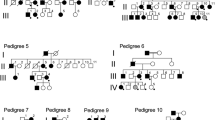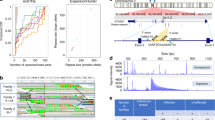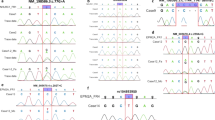Abstract
Progressive myoclonus epilepsy of the Unverricht–Lundborg type (EPM1; MIM 254800) is an autosomal recessive disorder with onset between 6 and 13 years followed by variable progression to mental deterioration and cerebellar ataxia1. It is a rare disorder but more common in Finland (1 in 20,000) and the western Mediterranean1,2. Two point mutations in the cysteine proteinase inhibitor gene cystatin B (CSTB), proved that this gene is responsible for EPM1 (ref. 3). An extensive search in the CSTB gene revealed mutations accounting only for 14% of the 58 unrelated EPM1 alleles studied4. Here we report that the majority of EPM1 alleles contain expansions of a dodecamer (12-mer) repeat located about 70 nucleotides upstream of the transcription start site nearest to the 5′ end of the CSTB gene. Normal alleles contain 2 or 3 copies of this repeat whereas mutant alleles contain more than 60 such repeats and have reduced levels of CSTB messenger RNA in blood but not in cell lines. 'Premutation' CSTB alleles with 12–17 repeats show marked instability when transmitted to offspring.
This is a preview of subscription content, access via your institution
Access options
Subscribe to this journal
Receive 51 print issues and online access
$199.00 per year
only $3.90 per issue
Buy this article
- Purchase on Springer Link
- Instant access to full article PDF
Prices may be subject to local taxes which are calculated during checkout
Similar content being viewed by others
References
Norio, R. & Koskiniemi, M. Progressive myoclonus epilepsy: genetic and nosological aspects with special reference to 107 Finnish patients. Clin. Genet. 15, 82–398 (1979).
Genton, P., Michelucci, R., Tassinari, C. A. & Roger, J. The Ramsay-Hunt syndrome revisited: Mediterranean myoclonus versus mitochondrial encephalomyopathy with ragged-red fibers and Baltic myoclonus. Acta Neural. Scand. 81, 8–15 (1990).
Pennacchio, L. A. et al. Mutations in the gene encoding Cystatin B in progressive myoclonus epilepsy (EPM1). Science 271, 1731–1734 (1996).
Lalioti, M. D. et al. Identification of mutations in Cystatin B, the gene responsible for the Unverricht-Lundborg type of progressive myoclonus epilepsy (EPM1). Am. J. Hum. Genet. 60, 342–351 (1997).
Lafrenière, R. G. et al. Unstable insertion in the 5′ flanking region of the cystatin B gene is the most common mutation in progressive myoclonus epilepsy type 1, EPM1. Nature Genet. 15, 298–302 (1997).
Lehesjoki, A.-E. et al. Localisation of the EPM1 gene for progressive myoclonus epilepsy on chromosome 21: linkage disequilibrium allows high resolution mapping. Hum. Mol. Genet. 2, 1229–1234 (1993).
Dausset, J. et al. Centre d'etude du polymorphisme humain (CEPH): collaborative genetic mapping of the human genome. Genomics 6, 575– 577 (1990).
Talbot, C. C. et al. The tetranucleotide repeat polymorphism D21S1245 demonstrates hypermutabiity in germline and somatic cells. Hum. Mol. Genet. 4, 1193–1199 (1995).
Labauge, P. et al. Allelic heterogeneity of Mediterranean myoclonus. Ann. Neurol. (in the press).
Paulson, H. L. & Fischbeck, K. H. Trinucleotide repeats in neurogenetic disorders. Annu. Rev. Neurosci. 19, 79–107 (1996).
Ashley, C. T. & Warren, S. T. Trinucleotide repeat expansion and human disease. Annu. Rev. Genet. 29, 703–728 (1995).
Richards, R. I. & Sutherland, G. R. Dynamic mutations: a new class of mutations causing human disease. Cell 70, 709–712 (1992).
Campuzano, V. et al. Friedreich's ataxia: autosomal recessive disease caused by an intronic GAA triplet repeat expansion. Science 271, 1423–1427 (1996).
Yu, S. et al. Human chromosomal fragile site FRA16B is an amplified AT-rich minisatellite repeat. Cell 88, 367–374 (1996).
Turk, V. & Bode, W. The cystatins: protein inhibitors of cysteine proteinases. FEBS Lett. 285, 213–219 (1991).
Pieretti, M. et al. Absence of expression of the FMR-1 gene in fragile X syndrome. Cell 66, 817–822 (1991).
Gecz, J., Gedeon, A. K., Sutherland, G. R. & Mulley, J. C. Identification of the gene FMR2, associated with FRAXE mental retardation. Nat. Genet. 13, 105–108 (1996).
Gu, Y., Shen, Y., Gibbs, R. A. & Nelson, D. L. Identification of FMR2, a novel gene associated with the FRAXE CCG repeat and CpG island. Nat. Genet. 13, 109–113 (1996).
Fu, Y.-H. et al. Decreased expression of myotonin-protein kinase messenger RNA and protein in adult form of myotonic dystrophy. Science 260, 235–238 (1993).
Sabouri, L. A. et al. Effect of the myotonic dystrophy (DM) mutation on mRNA levels of the DM gene. Nature Genet. 4, 233–238 (1993).
Oberle, I. et al. Instability of a 550-base pair DNA segment and abnormal methylation in fragile X syndrome. Science 252, 1097–1102 (1991).
Knight, S. J. L. et al. Trinucleotide repeat amplification and hypermethylation of a CpG island in FRAXE mental retardation. Cell 74, 127–134 (1993).
Verkerk, A. J. et al. Identification of a gene (FMR-1) containing a CGG repeat coincident with a breakpoint cluster region exhibiting length variation in fragile X syndrome. Cell 65, 905–914 (1991).
Brook, J. D. et al. Molecular basis of myotonic dystrophy: expansion of a trinucleotide (GTG) repeat at the 3′ end of a transcript encoding a protein kinase family member. Cell 68, 799–808 (1992).
Mach, B., Steimle, V., Martinez-Soria, E. & Reith, W. Regulation of MHC class II genes: lessons from a disease. Annu. Rev. Immunol. 14, 301–331 (1996).
Levine, M. & Manley, J.-L. Transcriptional repression of eukaryotic promoters. Cell 59, 405–408 (1989).
Youssoufian, H. & Lodish, H. F. Transcriptional inhibition of the murine erythropoietin receptor gene by an upstream repetitive element. Mol. Cell. Biol. 13, 98–104 (1993).
Rawlings, N. D. & Barrett, A. J. Families of cysteine peptidases. Meth. Enzymol. 244, 461–486 (1994).
Takahashi, A. & Earnshaw, W. C. ICE-related proteases in apoptosis. Curr. Opin Genet. Dev. 6, 50–55 (1996).
Pennacchio, L. A. & Myers, R. M. Isolation and characterization of the mouse cystatin B gene. Genome Res. 6, 1103–1109 (1996).
Author information
Authors and Affiliations
Rights and permissions
About this article
Cite this article
Lalioti, M., Scott, H., Buresi, C. et al. Dodecamer repeat expansion in cystatin B gene in progressive myoclonus epilepsy. Nature 386, 847–851 (1997). https://doi.org/10.1038/386847a0
Received:
Accepted:
Issue Date:
DOI: https://doi.org/10.1038/386847a0
This article is cited by
-
A deep population reference panel of tandem repeat variation
Nature Communications (2023)
-
R.ROSETTA: an interpretable machine learning framework
BMC Bioinformatics (2021)
-
Variable number tandem repeats mediate the expression of proximal genes
Nature Communications (2021)
-
ExpansionHunter Denovo: a computational method for locating known and novel repeat expansions in short-read sequencing data
Genome Biology (2020)
-
Drug Treatment of Progressive Myoclonic Epilepsy
Pediatric Drugs (2020)
Comments
By submitting a comment you agree to abide by our Terms and Community Guidelines. If you find something abusive or that does not comply with our terms or guidelines please flag it as inappropriate.



